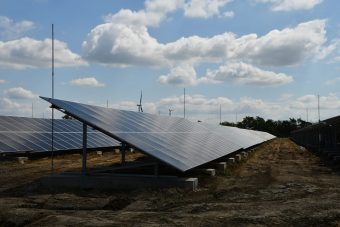The Kostolac region has long been renowned for its mines and thermal power plants, and it was here that coal production in Serbia first commenced in 1870. It has been a birthplace of ideas and the realization of projects that have strengthened Serbia’s power sector. Even now, Kostolac is at the forefront of new projects that will contribute to increasing the share of renewable energy sources, giving this symbolically mining- and thermal-based area a key role in decarbonizing and greening electricity production.
In addition to the well-known thermal power plants with a capacity of almost 1,300 megawatts, this year the energy strength of the Electric Power Industry of Serbia (EPS) will increase by another 76 megawatts of green energy. The solar power plant Petka has been completed — the first EPS solar plant in Kostolac. Its significance is further enhanced by the fact that it was built on the external landfill of the Ćirikovac open-pit mine. In this way, an old mining dump site is being repurposed to generate new energy.

“The solar power plant and wind park projects in Kostolac are just the beginning of our decarbonization process. With investments that increase the share of renewables, EPS demonstrates its commitment to achieving decarbonization and carbon neutrality,” said Dušan Živković, General Director of EPS.
The Petka solar power plant spans approximately 15 hectares, boasting an installed capacity of 9.75 megawatts and a projected annual production of 13.7 gigawatt-hours. The investment is valued at around 1.4 billion dinars and is financed with EPS’s own funds.
This first photovoltaic plant in Kostolac generates electricity by converting unaccumulated solar radiation into direct current through semiconductor-based (PV) solar modules. A total of 18,720 photovoltaic modules were installed at an angle of 25 degrees, each with a power rating of 580 W and an efficiency of 21 percent. The solar plant is equipped with 98 inverters — 97 rated at 100 kW and one at 50 kW. Additionally, the Petka solar plant features 10 transformer stations and one switchgear facility, from which the electricity is transferred to the Požarevac substation. As this is a pilot project and a relatively small plant (about ten megawatts), the panels are mounted on fixed supports.
IN FOCUS:
- The Future Is Green – Japan’s Climate Goals
- EBRD – Driving Serbia’s Green Transition and Sustainable Development
- Challenges and Opportunities for Montenegro on the Path to a Circular Economy
The investment is economically viable. The payback period for the invested funds is estimated at 12 years, while the operational life of the plant is 25 years. After that, only the panels need to be replaced, while the existing structures, roads, and infrastructure — which constitute a significant portion of the total investment — remain intact. Replacing the panels effectively revitalizes the plant for another 25 years of operation. The construction of the Petka plant was carried out by a consortium led by GAT from Novi Sad. Other members of the group include the Novi Sad-based Mio Company and two Hungarian firms — BSD Invest Europe Zrt from Budapest and Levi-Solar Kft. from the town of Zakanjsek.
The Petka solar plant is joined by another renewable energy (RES) facility nearby — EPS’s first wind park, Kostolac, with a capacity of 66 megawatts. All 20 wind turbines have been installed, and construction of the substation, switchgear, and internal cable network is underway, enabling wind energy production to commence by the end of this year. This facility, too, is being built on reclaimed overburden dumps, confirming EPS’s commitment to utilizing all available resources. The project covers four locations: Drmno, Petka, Ćirikovac, and Klenovnik. The planned annual production of the Kostolac wind park is 187 million kilowatt-hours — enough to supply about 30,000 households with green electricity.
The project is financed with a loan from the German development bank, KfW, worth 110 million euros, and EPS has also been granted an additional 30 million euros in non-repayable funds from the European Union through the Western Balkans Investment Framework (WBIF). Project consultants are Fichtner GmbH & Co. and Energoprojekt Entel AD. At the same time, procurement of the wind turbines, towers, substations, and switchgear is being handled by a consortium of Siemens Gamesa Renewable Energy A/S from Denmark and Siemens Gamesa Renewable Energy from Belgrade.
Prepared by Milena Maglovski
